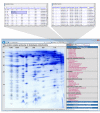Functional Annotation of 2D Protein Maps: The GelMap Portal
- PMID: 22639671
- PMCID: PMC3355635
- DOI: 10.3389/fpls.2012.00087
Functional Annotation of 2D Protein Maps: The GelMap Portal
Abstract
In classical proteome analyses, final experimental data are (a) images of 2D protein separations obtained by gel electrophoresis and (b) corresponding lists of proteins which were identified by mass spectrometry (MS). For data annotation, software tools were developed which allow the linking of protein identity data directly to 2D gels ("clickable gels"). GelMap is a new online software tool to annotate 2D protein maps. It allows (i) functional annotation of all identified proteins according to biological categories defined by the user, e.g., subcellular localization, metabolic pathway, or assignment to a protein complex and (ii) annotation of several proteins per analyzed protein "spot" according to MS primary data. Options to differentially display proteins of functional categories offer new opportunities for data evaluation. For instance, if used for the annotation of 2D Blue native/SDS gels, GelMap allows the identification of protein complexes of low abundance. A web portal has been established for presentation and evaluation of protein identity data related to 2D gels and is freely accessible at http://www.gelmap.de/.
Keywords: data annotation; data visualization; mass spectrometry; proteomics; software; two-dimensional gel electrophoresis; web portal.
Figures


References
-
- Giavalisco P., Nordhoff E., Kreitler T., Klöppel K. D., Lehrach H., Klose J., Gobom J. (2005). Proteome analysis of Arabidopsis thaliana by two-dimensional gel electrophoresis and matrix-assisted laser desorption/ionisation-time of flight mass spectrometry. Proteomics 5, 1902–191310.1002/pmic.200401062 - DOI - PubMed
-
- Joshi H. J., Hirsch-Hoffmann M., Baerenfaller K., Gruissem W., Baginsky S., Schmidt R., Schulze W. X., Sun Q., van Wijk K. J., Egelhofer V., Wienkoop S., Weckwerth W., Bruley C., Rolland N., Toyoda T., Nakagami H., Jones A. M., Briggs S. P., Castleden I., Tanz S. K., Millar A. H., Heazlewood J. L. (2011). MASCP Gator: an aggregation portal for the visualization of Arabidopsis proteomics data. Plant Physiol. 155, 259–27010.1104/pp.110.168195 - DOI - PMC - PubMed
LinkOut - more resources
Full Text Sources

